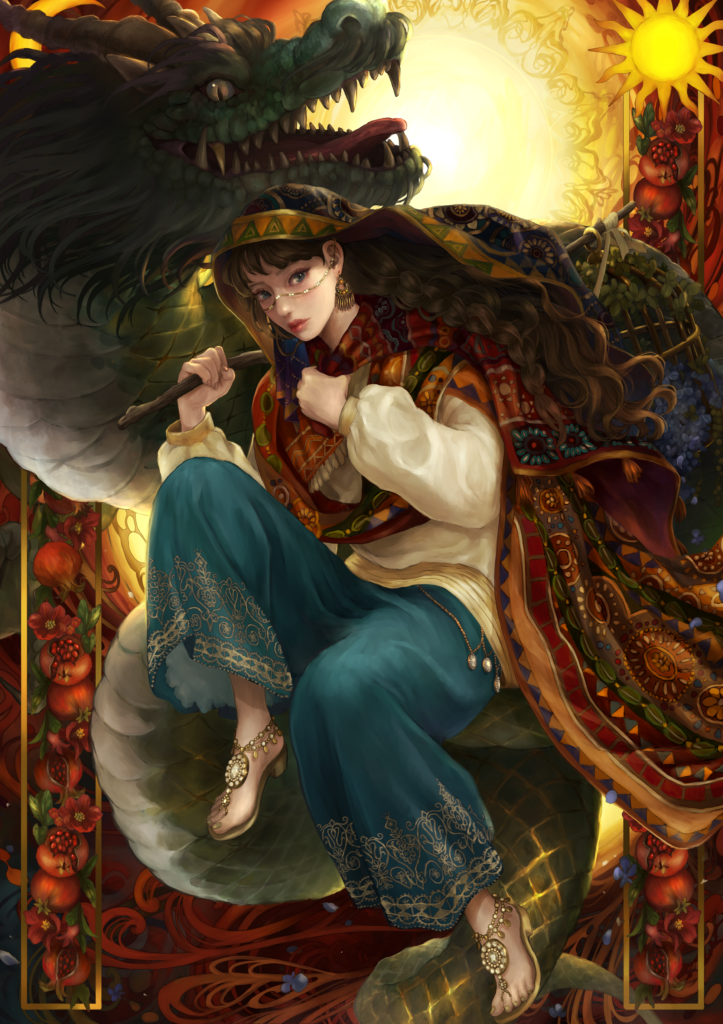
description
ある日、北風と太陽がどちらが強いかで言い争いをしていた。
ふたりは旅芸人のマントを脱がせた方が勝ちと決め、まず北風から始めることにした。
北風は力いっぱい吹き付けて 彼女のマントを吹き飛ばそうとするが、
寒さを嫌がった彼女はマントをしっかりと押さえてしまった。
強さが足りないと思った北風は 竜となり竜巻を起こし始めたが、
彼女は重ねて服を着るばかりで、北風もついには疲れ果て、太陽と交代してしまった。
太陽はまず彼女を優しく温めて、彼女が少しずつ着込んだ服を脱いでいくのを見ながら、だんだんと熱を強めていった。
とうとう彼女は暑さに耐えかねて、自らマントを脱いでしまった。
こうして勝負は太陽の勝ちとなった。
イソップ寓話の「北風と太陽」よりインスパイア
あとがき
イソップ寓話の中でもとても有名な「北風と太陽」をテーマに創作しました。
この物語は何を教訓にしているかというと、北風のように力づくで強制しようとしてもかえって人は心を閉ざしてしまうので、太陽のようにゆっくりと相手を思いやりながら説得する方が効果的だということを説いています。これは様々な対人関係の場面においてハッとさせられる方は少なくないのではないでしょうか。
北風の強引さや荒々しさ、厳しさを表現する上で 北風のキャラクターは龍にしました。龍は水神で知られるモチーフですが、雷雲や嵐を呼び、竜巻となって飛翔するとも言われています。この部分はわたしの創作で、実際の物語に龍は登場しません。
太陽は、温かさや愛情、思いやり、成功の象徴であり、北風とは違いゆっくりと時間をかけたという点も勝因だと思うので、それらを背景で少し抽象的に表現しています。
竜巻に巻かれ、太陽でジリジリと照らされた悲惨な女性は、ロベリアの花が詰まった鳥籠を背負っています。ロベリアの花は毒性があるため、「悪意」という怖い意味を持っています。
これはそのまま悪意に捕らわれていることを表していて、今まさに北風と太陽によって正しい道へと導かれようとしているのでしょう。
元々「北風と太陽」はギリシャ神話がモデルとなっているので、装飾のざくろもギリシャ神話より抜粋しました。冥界の王に拉致されたペルセポネは、冥界で何も食べてはいけないという禁忌を知らず、ざくろを食べてしまいます。
それによって1年の半分を冥界で過ごすことを余儀なくされたという逸話から、ざくろは欲望や誘惑、愚かさといった意味を孕むようになりました。
この禁断の果実ざくろは、冥界のシンボルとして「死と再生」を象徴しています。
もしいま目の前にいる自分の大切な人を、正しい道へと導かなければならないとしたらどうするでしょう。
この物語はそれを問いかけているのです。
description
One day, the North Wind and the Sun were arguing over who was stronger.
They decided that the one who could get the traveling entertainer to take off her cloak would win, so they started with the north wind first.
The north wind blew with full force, trying to blow her cloak off, but she didn’t want to be cold, so she held the cloak tight.
Feeling underpowered, the North Wind transformed into a dragon and began to create a tornado, but she was only getting more and more clothed.
The north wind finally grew tired and was replaced by the sun.
The sun first warmed her gently, and then gradually increased its heat as she gradually took off the clothes she had put on.
At last she could not stand the heat and took off her cloak herself.
Thus the sun won.
This is a story about how persuasion is more effective than coercion.
Inspired by Aesop’s fable “The North Wind and the Sun
after word
I created this work on the theme of “The North Wind and the Sun,” a very famous Aesop’s Fable.
The lesson of this story is that people will close their minds if you try to force them by force like the north wind, and that it is more effective to persuade them slowly and compassionately like the sun.
I think this is a great reminder for many people in a variety of interpersonal relationships.
In expressing the forcefulness, roughness, and harshness of the North Wind, I made the character of the North Wind a dragon.
The dragon is a motif known as the water god, but it is also said to call forth thunderclouds and storms, and to fly as a tornado.
This part of the story is my own creation, and the dragon does not appear in the actual story.
The sun is a symbol of warmth, love, compassion, and success.
I think the fact that it took its time, unlike the north wind, is also a winning factor, so these are expressed in the background in a slightly abstract way.
The woman is carrying a birdcage filled with lobelia flowers.
Lobelia flowers are toxic and have the scary meaning of “malice“.
This is a scene that represents being caught in the grip of malice and is about to be guided to the right path by the north wind and the sun.
Since “The North Wind and the Sun” was originally modeled on Greek mythology, the pomegranate decoration was also referenced from Greek mythology.
Abducted by the king of the underworld, Persephone eats a pomegranate, unaware of the prohibition against eating anything in the underworld.
The anecdote that Persephone had to spend half of the year in the underworld because of this has given pomegranates the meaning of desire, temptation, and foolishness.
This forbidden fruit, the pomegranate, is a symbol of the underworld, symbolizing “death and rebirth.
What would you do if you had to lead your loved one, who is in front of you right now, down the right path?
That is the question this story asks.

